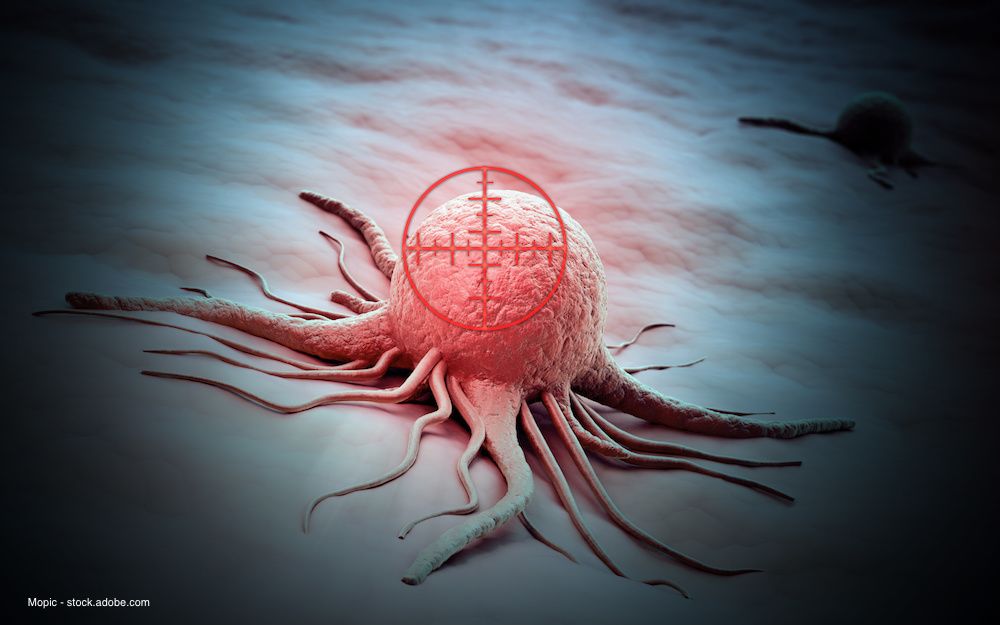Publication
Article
Urology Times Journal
Bladder Ca: Genetic testing, targeted therapies signal a new era of precision medicine
Author(s):
“We’re in an era of more personalized or precision medicine, and the ability to target cancer treatment to a patient’s specific genetic mutation or biomarker is becoming the standard,” according to Richard Pazdur, MD.

The FDA announced in April 2019 that it had approved erdafitinib (Balversa), the first personalized therapy targeting a genetic alteration for treatment of advanced bladder cancer.
“We’re in an era of more personalized or precision medicine, and the ability to target cancer treatment to a patient’s specific genetic mutation or biomarker is becoming the standard,” Richard Pazdur, MD, acting director of the FDA Oncology Center of Excellence, said at the time of the approval.
There are other firsts when it comes to erdafitinib. It is the first fibroblast growth factor receptor 3 (FGFR3) inhibitor and first oral agent approved for the treatment of bladder cancer, according to Arlene Siefker-Radtke, MD, professor of genitourinary medical oncology at The University of Texas MD Anderson Cancer Center, Houston.
Determining if advanced bladder cancer patients are candidates for the FGFR3 inhibitor involves genetically testing bladder cancer tumor tissue for the presence of an FGFR mutation, according to Yair Lotan, MD, professor and chief of urologic oncology at UT Southwestern Medical Center in Dallas.
Read: The case for transperineal prostate biopsy vs. the transrectal approach
“For bladder cancer patients who have either metastatic disease or patients with advanced disease who might become metastatic, there is value in knowing whether or not they have FGFR mutations, so one would know whether or not erdafitinib is a treatment option available to them,” Dr. Lotan said.

Tumor genetic testing with a tumor specimen is different than the clinical genetic testing for germline heritable mutations, according to Elizabeth Plimack, MD, MS, chief of genitourinary medical oncology at Fox Chase Cancer Center, Philadelphia.
“Fortunately, with bladder cancer we often have banked tissue from a patient’s biopsy or surgery,” Dr. Plimack said. “But it’s really the medical oncologist that’s going to order the test and choose which specimen to send because the test result is most relevant at the point of metastases. A patient with localized disease may never be metastatic or be a candidate, in which case they do not require testing. For a patient with metastatic disease who then quickly recurs, based on currently available data, they should go through prior treatment before erdafitinib makes sense. Erdafitinib is not usually a first-line treatment.”
Urologists often see bladder cancer patients whose disease has progressed despite standard treatment that might involve surgery and chemotherapy. Some metastatic patients have had the option of immunotherapy, but if that was ineffective, treatment options were limited, according to urologist Badrinath Konety, MD, MBA, professor of urology at the University of Minnesota, Minneapolis.
Now, with erdafitinib, which binds to FGFR1, FGFR2, FGFR3, and FGFR4, many of these patients have a new option for second-line therapy.

“The other option of course is immunotherapy,” Dr. Konety said. “The advantage of erdafitinib is that it’s oral, it seems to be well-tolerated, and it’s based on a receptor that is more widely expressed as opposed to PD-1 or PD-L1, which are not as widely expressed. The FGFR mutation is one of the most common mutations you’ll find in bladder cancer, so more patients may be eligible for this treatment.”
The urologist’s role in erdafitinib treatment could soon expand.
“There are some clinical trials that are looking at FGFR inhibitors in patients with Bacillus Calmette-Guerin (BCG)-unresponsive disease,” Dr. Lotan said. “It wouldn’t yet be standard of care to test for FGFR in a patient without advanced disease, but that doesn’t mean that in the near future-the next few years-it won’t become something of value.”
Biomarkers, in general, have many potential uses in bladder cancer treatment. In fact, the International Consultation of Urologic Diseases has devoted 2020 to molecular markers and their roles in bladder, prostate, and other urologic cancers, according to Dr. Lotan, who is editor for the ICUD’s bladder section.
Next: The importance of tissue testingThe importance of tissue testing
Erdafitinib’s approval and potential impact on response rate and survival highlight why it’s increasingly important for patients to have their tumor tissues tested, according to Dr. Siefker-Radtke.
Also see: ASCO publishes prostate cancer biomarker guideline

“In the phase II trial [N Engl J Med 2019; 381:338-48], the response rate was about 40% in patients with FGFR-altered tumors, and overall median survival was about 13.8 months,” said Dr. Siefker-Radtke, who led the phase II trial.
In a group of patients who have progressed despite chemotherapy, that’s a promising result and provides patients an opportunity for an additional treatment if they have an FGFR3 alteration, Dr. Siefker-Radtke said.
It’s important to test patients with incurable bladder cancer when they are first diagnosed with stage 4 disease because obtaining the tissue takes time, Dr. Siefker-Radtke said.
“Knowing the presence of this mutation early allows patients to either participate in clinical trials of oral agents targeting FGFR3 or even consider some combination strategies for targeting FGFR3,” she said.
The bigger picture
FGFR3 is among the early targets identified in bladder cancer. About 60% of patients with low-grade, low-stage bladder cancer are thought to have FGFR3 alterations. And the prevalence of these alterations is estimated to be from 15% to 20% in patients with stage 4 urothelial bladder tumors, Dr. Siefker-Radtke said.
“This may actually be higher in urothelial tumors of the renal pelvis where the presence of these mutations has been reported as high at 35%,” she said.
Patients with upper urinary tract cancer have even fewer treatment options and less definitive data from clinical trials. If the trial data on erdafitinib in patients with upper tract tumors does pan out, “that’s a real need that could be filled by this drug,” Dr. Konety said.
Dr. Siefker-Radtke said testing for FGFR3 mutations in advanced bladder cancer patients is top priority when she is testing for mutations.
“Following that, there is more limited data on the need for additional testing,” she said. “There is some data that if a patient is not eligible for cisplatin and their tumors are PD-L1 high, then they might benefit from a single-agent immune checkpoint inhibitor. So, that would be the second marker that I would consider testing, but only in patients who haven’t had prior chemotherapy for their stage 4 disease,” Dr. Siefker-Radtke said.
The FDA has approved several checkpoint inhibitors for advanced bladder cancer, but only about one in five patients benefit from these agents, according to Dr. Siefker-Radtke.
Promising novel agents are targeting other pathways, including the human epidermal growth factor receptor 2 (HER2) pathway and mammalian target of rapamycin (mTOR) pathway, but trials looking at those pathways in the setting of bladder cancer have not yet demonstrated strong benefit, Dr. Lotan said.
Read: PSMA-targeted therapy well tolerated in men with mCRPC
“There have been rare patients who have had success from other targeted therapies. But no other targeted therapy has been uniformly approved for patients with bladder cancer,” he said.
Next: Present, future bladder cancer testsPresent, future bladder cancer tests
Molecular testing in bladder cancer is limited at this time, according to Dr. Lotan.
“Most people use urine cytology. Some people use UroVysion, which is a FISH [fluorescence in situ hybridization] assay for patients who have atypical cytology. It is a genetic marker looking for chromosomal abnormalities in cells in the urine. It probably should be used selectively, if at all,” he said. Additional diagnostic urine tests for recurrent bladder cancer are BTA STAT, BTA TRAK, and NMP22.
Another available group of tests is the CxBladder (Pacific Edge), which combines biomarker genes with known bladder cancer risk factors to help rule out cancer in patients with hematuria. (Also see, “Bladder cancer biomarker test accurately adjudicates atypical cytology.")

“It is currently used by some people to help with surveillance or detection in patients with hematuria. There are several studies that show it has improved sensitivity over cytology. There are still some issues with how exactly to incorporate these markers clinically, and there’s some concern over risk of false-positive results,” said Dr. Lotan, who was among the researchers to study CxBladder.
Dr. Lotan estimates there are 20 to 30 markers in development for bladder cancer detection or surveillance that have yet to be validated. This includes the UroSEEK test, developed by Johns Hopkins researchers, which detects DNA mutations identified with urothelial cancers in urine samples.
Dr. Lotan continues to study the Decipher Bladder test, a genetic test aimed at classifying muscle-invasive bladder cancer’s molecular subtype. This test may help determine which patients might benefit from neoadjuvant chemotherapy before radical cystectomy or accurate staging of the disease.
“There is still some validation that needs to be done before the Decipher test should be used routinely,” Dr. Lotan said.
In fact, there are multiple trials using biomarkers looking to predict which patients would and would not likely response to chemotherapy, according to Dr. Lotan.
Also see: How the Cancer Genome Atlas has impacted bladder Ca management
“There is significant interest in trials that are trying to identify patients who are highly likely to respond with the hope that they may be enrolled and spare their bladder,” he said. “There is also interest in identifying which patients might have micrometastatic disease after the bladder is removed so they may get adjuvant therapy.”
Understand before you educate
Dr. Lotan said it’s important for urologists and other providers to validate clinical benefits before using any genetic testing.
“It’s important to know what the goals of the test are and how it would change management of the patient. For many markers, it’s not yet clear how they would change management. While they provide additional information over clinical information alone, sometimes that information doesn’t tell you exactly what to do and in many cases it can lead to anxiety and added costs,” he said.
Pursuing more targeted treatment for bladder cancer is one of many areas of study to optimize bladder cancer treatment, according to Dr. Plimack.
“I think we’re looking at every angle we can,” she said. “We’ve looked at immunotherapy and harnessing the immune system. There is cellular therapy on the horizon for urothelial cancer, with engineered T-cell therapy. There is standard targeted therapy like erdafitinib. There’s targeted chemotherapy with enfortumab vedotin, an antibody drug conjugate where the antibody is tagged to the target on the tumor cell but the conjugate is a chemo drug. And we’re still refining how we give regular chemotherapy and whether to give it in combination versus separately.”
Disclosures
Dr. Siefker-Radtke has consulting and advisory ties with Janssen, Merck, NCCN, Bristol-Myers Squibb, AstraZeneca, BioClin Therapeutics (Rainier Therapeutics), Bavarian Nordic, Seattle Genetics, Nektar, Genentech, Inovio Pharmaceuticals, and EMD Serono. She receives research funding from NIH, Michael and Sherry Sutton Fund for Urothelial Cancer, Janssen, Takeda, Bristol-Myers Squibb, BioClin Therapeutics, Nektar and Merck. Dr. Lotan reports that in the last 2 years he has: consulted, advised, and/or conducted research for Abbott, Pacific Edge, FKD Therapies Oy, BioCanCell, Decipher Biosciences, Cepheid, AstraZeneca, Merck, MDxHealth, Photocure, Ferring, and CAPS Medical; served on the data safety monitoring board for Urogen and Synergo; and held a leadership position with Vessi Medical. Dr. Konety is a clinical trial investigator for Merck, Pacific Edge, Photocure, FKD Therapies Oy, and Bristol-Myers Squibb. He has consulted for Ferring, Photocure, and Nucleix. Dr. Plimack is a scientific advisor for Bristol-Myers Squibb, Flatiron, Genentech, Merck, Seattle Genetics; does data safety monitoring for AstraZeneca and Pfizer; and receives grants for clinical research from Astellas, Bristol-Myers Squibb, Genentech, Merck, Peloton, Pfizer, and AstraZeneca.

































